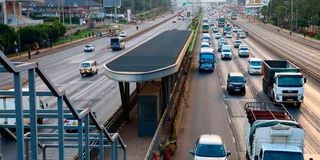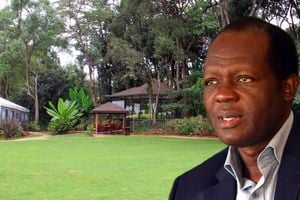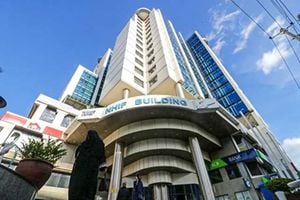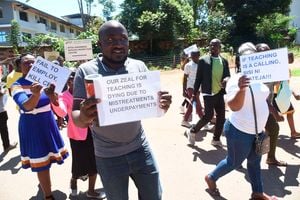Wanted: International bidders for Sh7.6bn BRT to be built on Outer Ring Road

The Bus Rapid Transport (BRT) Station at Safari Park along Thika Superhighway pictured on December 9, 2023. The multi-million shilling project with it's partially completed stages lies idle even as the idea to improve the city’s public transport network, reducing travel costs and time remain a pipe dream.
The Kenya Urban Roads Authority (Kura) has invited international bids for the construction of a Bus Rapid Transport (BRT) line along the Outer Ring Road.
The construction of Line 5 of the BRT was to start last year.
Kura in 2022 signed a consultancy contract with the Korean Consortium led by Kunhwa Engineering & Consulting Co Ltd for the establishment of BRT along the 10.5 kilometre BRT line, which runs from where the demolished Taj Mall stood on North Airport Road to GSU headquarters in Ruaraka, Thika Road.
The Korean company won the consultancy contract worth Sh583 million.
On Tuesday, Kura, through a tender notice, announced plans for the line dubbed Nyati to be developed using a USD59 million (Sh7.6 billion) loan from Korea.
Kura Director-General Silas Kinoti said that the BRT Line 5 will traverse Ridgeways (Kiambu Road)-Balozi (Allsops) and Imara Daima and is funded by a loan through the Economic Development Cooperation Fund (EDCF) through the Export-Import Bank of Korea (Kexim)
“The project is designed to address some of the key challenges Nairobi faces, including traffic congestion and high carbon emissions, while also improving mobility accessibility and safety for citizens and also intends to apply a portion of the proceeds of this loan to payments under the contract for establishment of Bus Rapid Transit Line 5 Project,” said Mr Kinoti.
According to the tender notice, the 10.5-kilometre project entails a two-lane BRT line along the road, three river bridges, two overpass bridges and 13 BRT stations.
“The terms and conditions of the contract and payment by the bank, therefore, shall be subject in all aspects to the terms and conditions of the loan agreement, including the guidelines for the procurement under the EDCF loan. Except as the bank may specifically otherwise agree, no party other than the borrower shall derive any rights from the loan agreement or have any claims on the loan proceeds,” the notice added.
Earlier this month, Kura conducted public participation to gather community feedback on the project.
The participation was held in Kamukunji, the Redeemed Gospel Church in Kware, Embakasi South, and at KAG Fedha off Outer Ring Road.
Easy accessibility
In one of the stakeholder meetings at the Deputy County Commissioner's Office in Embakasi West sub-County, Kura revealed that the BRT project aims to tackle key issues like traffic congestion and high carbon emissions, while also improving safety and accessibility for residents.
Kura further added works will involve the construction of three river bridges and two overpass bridges of approximately 1024m and 323m respectively and also the construction of 13 BRT stations.
The project will also entail the construction of new footbridges and modification of existing footbridges, installation of electro-mechanical works, construction of drainage system along the road, street lighting, landscaping works and improvements of Outer Ring Road.
The contractor will be required to construct a BRT depot of approximately 1365m2 floor area with parking spaces and access roads, fences and drains.
However, the project is restricted to firms from Korea and the work must be completed within 24 months.
The announcement comes exactly a year after President William Ruto signed a Sh8.7 billion deal with US foreign aid agency MCC for the acquisition of electric buses which will operate on Line 2 of the BRT.
The deal was signed on the sidelines of last year's United Nations General Assembly (Umga) in New York.
“The Blended Finance for BRT Project aims to catalyse private financing to support the acquisition of electric (or other low emission) buses to operate one or more lines of the bus rapid transit (BRT) system, currently being prepared for the Nairobi metropolitan area,” MCC said on its website.
“The project aims to facilitate the timely operation of BRT lines and contribute to the government of Kenya’s goals of reducing greenhouse gas emissions related to urban transportation.”
The funding was aimed at providing support to climate-friendly buses for the emerging BRT network that will ease traffic congestion in Nairobi.
MCC is an independent US government agency working to reduce global poverty through economic growth by providing time-limited grants and assistance to countries with standards for good governance.
Kenya secured a Sh14 billion loan from the African Development Fund (AfDB) in 2015 to build Outer Ring Road which is located in Nairobi’s Eastlands with the road transforming the densely populated Eastlands area.
The road’s expansion was among multiple road projects in the city which include the Thika Superhighway, three bypasses, Western Ring Roads and the expansion of five roads in Eastlands funded by the European Union.
During the construction period, service lanes to ease the expected traffic congestion were given priority before the contractor moved in to construct the inner lanes.
The project was undertaken by the Chinese company Sinohydro Corporation and saw the road expanded with multiple interchanges to cure the characteristic traffic congestion experienced currently.
The road passes through densely populated residential and industrial areas in Eastlands which contributed to high fares and cost of goods.
The project involved the construction of two lanes in each direction, service roads, 10-footbridges, non-motorised transport facilities and six interchanges.
The design also made provision for a nine-meter raised central median that was to later be developed into a BRT corridor.
Wider plan
BRT is part of the Nairobi Integrated Urban Development Master Plan, which is being implemented to end vehicular congestion in the CBD.
This will be the second BRT project in the capital city after the first project along Thika Road remains undone after the contractor abandoned the site following budget cuts that left it with pending bills running into billions of shillings.
Last year, Members of Parliament said the Sh5.58 billion BRT project in Nairobi has not offered value for money.
The two Chinese construction firms—STECOL Corporation in a joint venture with SMEDI—were contracted by the government to construct the 27.4-kilometre Ruiru-Nairobi Central Business District- Kenyatta National Hospital (KNH) BRT on February 12, 2020.
The construction is overseen by the Nairobi Metropolitan Area Transport Authority (Namata) and was to last 18 months. However, more than four years down the line, the project is yet to be completed, with the government having already pumped in Sh951.8 million in advance payment.
The BRT project has five lines—Ndovu, Simba, Chui, Kifaru and Nyati—all interlinked within the Nairobi CBD. Phase I of the project involved the 23.7-kilometre Ruiru-Nairobi CBD line, with Phase II being the 3.7-kilometre line from CBD to KNH.
Ndovu line is a 48.5-kilometre stretch gazetted in 2019 and covers Limuru-Kangemi-CBD-Imara Daima-Athi River-Kitengela. It is funded by the Chinese government. The Simba line is 73.5 kilometres, covering Rongai-Bomas-Nairobi CBD-Ruiru-Thika-Kenol and was funded by the government of Kenya.
Chui line is 81.2 kilometres long and has Tala-Njiru-Dandora-Nairobi CBD-Showground (Ngong road)-Ngong and is funded by the European Union and African Development Bank. Kifaru is the 30.8-kilometre Mama Lucy Hospital-Donholm-Nairobi CBD- T-Mall- Bomas-Karen-Kikuyu line. The Nyati line is 23.9 kilometres and covers Ridgeways-Balozi-Imara Daima.
“The design speed of the BRT lanes will be an average of 30 km/h, achieving one of the highest average speeds globally, leading to significantly shorter travel times on the BRT corridor,” says Namata.
According to data from the National Transport and Safety Authority, Outer Ring Road is one of the deadliest roads in the city.
A previous report by Namata estimated that traffic congestion in Nairobi costs the government Sh100 billion per year through wasted hours and fuel consumption.
Another report by Kura ranked Nairobi as the second most congested city in Africa after Lagos and the fourth most congested city in the world.





